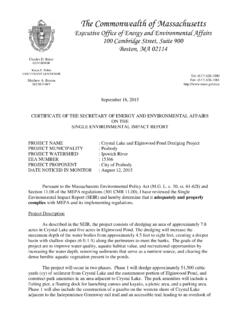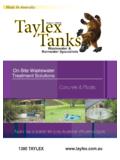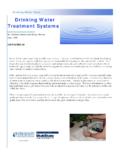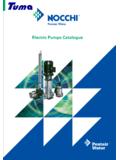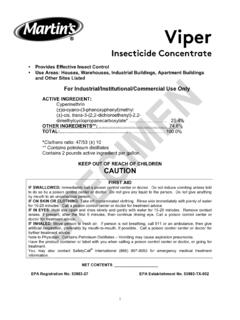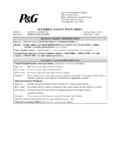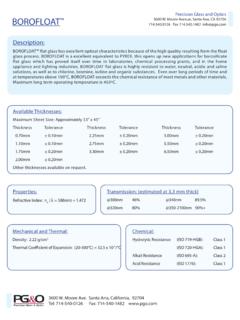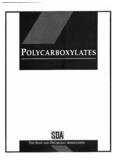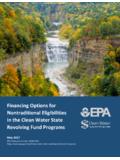Transcription of Postal Patron - Peabody, Massachusetts
1 Department of Public Service 50 Farm Avenue Peabody, MA 01960 PWS ID: 3229000 Presorted Postage Paid PERMIT No. 314 Peabody, MA THE CITY OF PEABODY 2013 WATER QUALITY REPORT Postal Patron To Our Customers: The Peabody Department of Public Services is committed to providing safe and high quality drinking water to our customers. To ensure delivery of a quality product, we have made significant investments in treatment facilities, water quality monitoring, and our distribution system. We are pleased to present you with the 2013 Water Quality Report. The EPA Stage 2 DBP Rule, which went into effect in 2012, requires water systems to meet locational running annual averages (LRAA) for Total Trihalomethanes (TTHM) at each of 8 sampling locations. In the past, the City had to report a combined running annual average (RAA) of all samples collected throughout the distribution system and was able to meet EPA requirements.
2 During 2013, our water system exceeded the maximum contaminant level of TTHM in Quarters 1, 2 and 3. The City has implemented a number of short-term and long-term solutions to meet this new rule. One of the substantial work projects was the construction of the chloramination system to reduce the TTHM. The Chloramination system has been online since January 6, 2014. The levels of TTHM have decreased since we implemented our improvement work and the City is currently meeting the requirement of the EPA Stage 2 DBPR . Please call Michael Sheu, Water Superintendent, at 978-536-5069 with any questions, comments, or concerns. Public Service: (978) 536-0600 Winona Water Treatment Plant: (978) 536-5069 Water Distribution: (978) 536-7121 Coolidge Water Treatment Plant: (978) 538-7573 Website: Peabody Water System and Water Quality Peabody s Water System: Peabody s drinking water is mainly supplied by the Coolidge and Winona Water Treatment Plants (WTP).
3 MWRA provides supplemental drinking water during high water demand months. There are five water storage tanks in the distribution system that provide water storage, water pressure, and fire protection for the City. Source of Water: At Winona WTP, water is pumped from Winona Pond for treatment. At Coolidge WTP, water is pumped from Suntaug Lake and Spring Pond for treatment. The source of water for Suntaug Lake and Winona Pond is the Ipswich River. Under MADEP s Water Management Act, withdrawing water from the Ipswich River is only allowed during winter and spring months. The DEP has characterized our surface water source susceptibility as moderate to high. Please visit for more information. Water Treatment: Coolidge and Winona Water Treatment Plants implement the following treatment steps: coagulation and sedimentation which remove particles from the water through flocculation and then settling, filtration which removes the remainder of the particles out of the water, primary disinfection which uses free chlorine to kill the harmful microbes, and secondary disinfection which uses monochloramine to control the biological activity in the distribution system.
4 Additionally at Coolidge WTP, free chlorine is used for pretreatment to oxidize the iron and manganese in the source water during the fall and winter months. What does this table tell me? The following contaminants were detected in the Peabody s drinking water system. All are below allowed levels except Total Trihalomethanes. The table also shows the amount (Average Level Detected) of each substance found in the water compared to the level allowed by law. We have also included information on substances found in MWRA drinking water, which made up about 20% of the water delivered to your homes in 2013. Barium (ppm)2/4 of drilling wastes or from metal refineries; Erosion of natural deposits Fluoride (ppm) additive, promotes strong teethNitrate (ppm)2/4 from fertilizer use; leaching from septic tanks, sewagePerchlorate (ppb)9/21 propellants, fireworks, munitions, flares, blasting agentsSodium (ppm)2/4 presents in the environmentSulfate (ppm)12/31 presents in the environmentRadium 226 (pCi/L)9/12 of natural deposits NTUB arium (ppm)2/4 of drilling wastes or from metal refineries; Erosion of natural deposits Fluoride (ppm) additive, promotes strong teethNitrate (ppm)2/4 from fertilizer use.
5 Leaching from septic tanks, sewageSodium (ppm)2/4 presents in the environmentSulfate (ppm)12/31 presents in the environmentRadium 226 (pCi/L)9/12 of natural deposits NTUT otal Coliform (% of samples) (July) of monthly samples0 NoNaturally present in the environment and animal wasteFree Chlorine (ppm) additive to control microbesHaloacetic Acids (HAA5, ppb) of ChlorinationTotal Trihalomethanes (TTHM, ppb) *By-product of ChlorinationLead (ppb)6/1 of household plumbing systemCopper (ppm)6/1 of household plumbing systemBarium (ppm) of drilling wastes or from metal refineries; Erosion of natural deposits Fluoride (ppm) additive, promotes strong teethNitrate (ppm) from fertilizer use; leaching from septic tanks, sewageNitrite (ppm) from fertilizer use.
6 Leaching from septic tanks, sewageMono-Chloramine (ppm)Daily propellants, fireworks, munitions, flares, blasting agentsSodium (ppm) presents in the environmentHaloacetic Acids (HAA5, ppb) of ChlorinationTotal Trihalomethanes (TTHM, ppb) of ChlorinationTotal Coliform (% of samples) (Nov) of monthly samples0 NoNaturally present in the environment and animal wasteMCLGV iolationPossible Sourcesn/aNoSoil runoffPlease visit for MWRA Water Quality ReportsContaminantDate CollectedAverage Level DetectedRange of DetectsMCLP ossible SourcesPossible Sources*Some people who drink water containing trihalomethanes in excess of the MCL over many years may experience problems with their liver, kidneys, or central nervous systems, and may have an increased risk of getting cancer.
7 Samples collected from the Coolidge WTP MCLMCLGV iolationPossible SourcesAverage Level DetectedRange of DetectsContaminantDate CollectedSoil runoff100% of samples < NTUS amples collected from the Winona WTP ContaminantDate CollectedAverage Level DetectedRange of DetectsMCL# of Site samplesViolationDate collectedn/aNo100% of samples < NTUE very 4 hoursMCLGV iolationAverage Level DetectedRange of DetectsContaminant90th PercentileRange of DetectsAction Level (AL)TurbidityTurbidity (NTU)Every 4 hoursDate CollectedSamples collected from the Distribution SitesMCLMCLGV iolationPossible SourcesContaminant Drinking Water and People with Weakened Immune Systems Some people may be more vulnerable to contaminants in drinking water than the general population. Immuno-compromised persons such as persons with cancer undergoing chemotherapy, persons who have undergone organ transplants, people with HIV/AIDS or other immune system disorders, some elderly, and infants can be particularly at risk from infections.
8 These people should seek advice about drinking water from their health care providers. EPA/CDC guidelines on appropriate means to lessen the risk of infection by Cryptosporidium and other microbial contaminants are available from the Safe Drinking Water Hotline (800-426-4791). Contamination in Bottle Water and Tap Water Sources of drinking water both tap water and bottled water; include rivers, lakes, streams, ponds, reservoirs, springs, and wells. As water travels over the surface of the land or through the ground, it dissolves naturally-occurring minerals and, in some cases, may even include radioactive material. Raw water may also pick up substances resulting from the presence of animals or from human activity. Contaminants that may be present in untreated source water, also called raw water, include Microbial contaminants, such as viruses and bacteria, which may come from septic systems, agricultural livestock operations and wildlife; Inorganic contaminants, such as salts and metals, which can be naturally occurring or result from urban storm water runoff, industrial or domestic wastewater discharges, oil and gas production and transportation, mining, or farming; Pesticides and herbicides, which may come from a variety of sources such as agriculture, urban storm water runoff, and residential uses.
9 Organic chemical contaminants, including synthetic and volatile organic chemicals, which are by-products of industrial processes and petroleum production, and can also come from gas stations, urban Storm water runoff, and septic systems; Radioactive contaminants, which can be naturally-occurring or be the result of oil and gas production and mining activities. In order to ensure that tap water is safe to drink, EPA prescribes regulations which limit the amount of certain contaminants in water provided by public water systems. FDA regulations establish limits for contaminants in bottled water which may provide protection to public health. Drinking water, including bottled water, may reasonably be expected to contain at least small amounts of some contaminants found in the environment.
10 The presence of contaminants does not necessarily indicate that water poses a health risk. More information about contaminants and potential health effects can be obtained by calling the Environmental Protection Agency s Safe Drinking Water Hotline (1-800-426-4791). Important Lead Information from EPA If present, elevated levels of lead can cause serious health problems, especially for pregnant women and young children. Lead in drinking water is primarily from materials and components associated with service lines and home plumbing. The Peabody Water Treatment Plants are responsible for providing high quality drinking water, but cannot control the variety of materials used in plumbing components. When your water has been sitting for several hours, you can minimize the potential for lead exposure by flushing your tap for 30 seconds to 2 minutes before using water for drinking or cooking.



